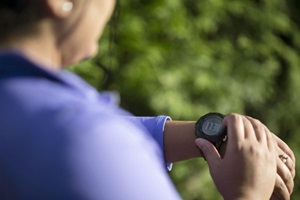Knowing Your Heart Rate

The first step is to find your resting heart rate. Your resting heart rate is the number of times your heart beats per minute while at rest. Check it in the morning after you have had a good night’s sleep and before you get out of bed. A healthy resting heart rate is 60-100 beats per minutes.
Later, at the end of your exercise and before you cool down, take your training heart rate. Your training zone is between 50-85% of your maximum heart rate (220 minus your age).
| Age | Target HR Zone 50-85% | Average Maximum Heart Rate, 100% |
|---|---|---|
| 20 years | 100-170 beats per minute (bpm) | 200 bpm |
| 30 years | 95-162 bpm | 190 bpm |
| 35 years | 93-157 bpm | 185 bpm |
| 40 years | 90-153 bpm | 180 bpm |
| 45 years | 88-149 bpm | 175 bpm |
| 50 years | 85-145 bpm | 170 bpm |
| 55 years | 83-140 bpm | 165 bpm |
| 60 years | 80-136 bpm | 160 bpm |
| 65 years | 78-132 bpm | 155 bpm |
| 70 years | 75-128 bpm | 150 bpm |
Your goal at every exercise session is to reach a level of intensity and duration to get your heart rate into that training zone. For the greatest health benefits, aim for 30-60 minutes of exercise per day within your target heart rate training zone.
Using a heart rate monitor to wear during exercise, makes it easier to monitor your heart rate – ensuring you are reaching and maintaining your Target Heart Rate to get the optimal benefits from your exercise program.
Waist Circumference
The circumference of your waist is important because it's a good indicator of how much abdominal, or visceral, fat you have — the fat you carry around your middle, including your belly. A little bit of that sort of fat is useful because it protects your vital organs, but too much can lead to an increased risk of chronic diseases like heart disease and type 2 diabetes.
A high waist measurement increases your risk for heart disease.
Your waist measurement is high if:
- Women: Waist measurement is more than 35 inches
- Men: Waist measurement is more than 40 inches
At the start of your exercise program take a pre-measurement of your waist by placing a measuring tape snugly around your bare belly, starting at your belly button. Take waist circumference measurements at the end of every month to track the improvements in health.
BMI
Body Mass Index (BMI) is a person’s weight in kilograms divided by the square of height in meters. A high BMI can be an indicator of high body fatness. BMI can be used to screen for weight categories that may lead to health problems but it is not diagnostic of the body fatness or health of an individual. For more information, click here.
At the start of your exercise program take a pre-measurement of your BMI. Take a post BMI measurement every 60 days. Take your height and weight and click on BMI Calculator, listed below, and enter your height and weight to calculate your BMI.
Use the BMI Calculator or BMI Tables to estimate your body fat. The BMI score means the following:
| BMI | |
| Underweight | Below 18.5 |
| Normal | 18.5–24.9 |
| Overweight | 25.0–29.9 |
| Obesity | 30.0 and Above |
Click here to learn more.